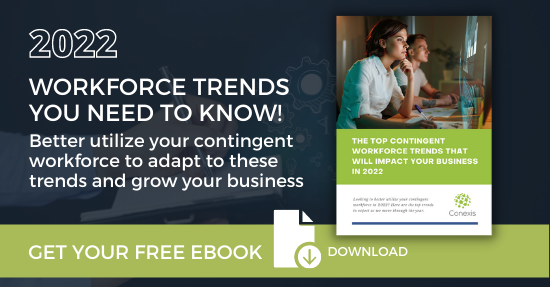The demand for contingent workers is increasing each year, as organizations look for new ways to acquire top talent, save money and stay agile in what is becoming an increasingly competitive jobs market.
It’s for this reason that 32 percent of companies, according to data from Gartner, have replaced salaried employees with contingent workers to cut down on costs and as a means to fill important skills gaps.
The contingent workforce is increasingly becoming the future of the modern workplace, and that means organizations will need to keep a close eye on this growing category. In fact, the companies that realize true ROI from their externally-sourced workforce will implement robust, strategic and centralized contingent workforce management programs.
In this blog we look at a four-step contingent workforce management framework that will define success. Before we get into that, however, let’s first dive into what contingent workforce management actually is.
What is contingent workforce management?
Businesses can gain a range of benefits from contingent workers (made up of independent contractors, freelancers, gig workers, consultants, contract workers and temporary workers), including:
- Improved business agility
- The ability to scale up and down rapidly
- Reduced spend
- Better workforce quality
But as with most business solutions, the contingent workforce comes with a range of risks, such as vendor performance, workforce misclassification and rogue spend, when not managed correctly.
That’s why for any organization utilizing contingent workers, a contingent workforce management program is essential.
So what exactly is it? Contingent workforce management is a strategic program that is designed, planned and implemented to reduce risk and improve the ROI of your contingent workforce.
It focuses on standardizing processes, centralizing information, performance reporting and building a company-wide approach so that all hiring managers across your business are working towards the common goal of fulfilling your company’s workforce requirements.
Are you looking to build an effective contingent workforce management program that improves the ROI your business realizes from its contingent workforce? Check out our four-step contingent workforce management framework below.
Our 4-step contingent workforce management framework
Step 1 - Analyze your workforce requirements
The first step to a successful contingent workforce management program is to develop a strategy for workforce planning. Workforce planning is the process used by a company to analyze its existing work force and plan for its future needs.
Workforce planning ensures businesses are able to fulfill their workforce goals through strategic talent acquisition based on both external factors, such as skill availability, and internal factors like the experience of the company’s existing team. Through continuous workforce planning your organization can truly understand what contingent workers it needs to source
Step 2 - Systemize and standardize contingent worker acquisition across your entire business
Whether your organization is a huge enterprise with multiple locations or a small business with different departments, it’s likely that your current hiring managers are managing their own processes and engaging staffing agencies on their own terms.
The problem is this leads to inconsistent access to talent and non-standardized staffing agency rates. A contingent workforce management program should be a business-wide initiative that creates standardized and centralized processes, so that you have complete visibility into the contingent workers being hired and how much they cost.
Step 3 - Connect with the right staffing agencies, not just the “best”
It might seem like a simple solution to just partner with the “best” staffing agency, but that doesn’t necessarily mean you are partnering with the right staffing vendor. A staffing agency acts as an extension of your talent acquisition team, so you need to work with a partner that is specialized and experienced in finding the talent you need.
Depending on your organization, one staffing agency may be enough to fulfill your needs, but other businesses may need to partner with a wide range of agencies with different expertise and specialization in different locations. Partnering with the right agency based on your company’s unique needs will dramatically improve the quality of your contingent talent.
Step 4 - Underpin your entire contingent workforce program with a vendor management system
To ensure your contingent workforce management program is working effectively, you need to gain visibility and control over the program, your contingent workers, and the staffing agencies you partner with. That’s where the implementation of a vendor management system comes in.
VMS software will centralize and automate all of the processes associated with managing both contingent workers and staffing agencies into one platform. Through the use of a VMS your business can gain unique insights and data into how your program is improving and where you can make improvements that save you money and improve workforce quality.
Interested in saving money and improving talent quality from your contingent workforce management program? Book a demo of Conexis VMS today and learn how our innovative vendor management system can help.





